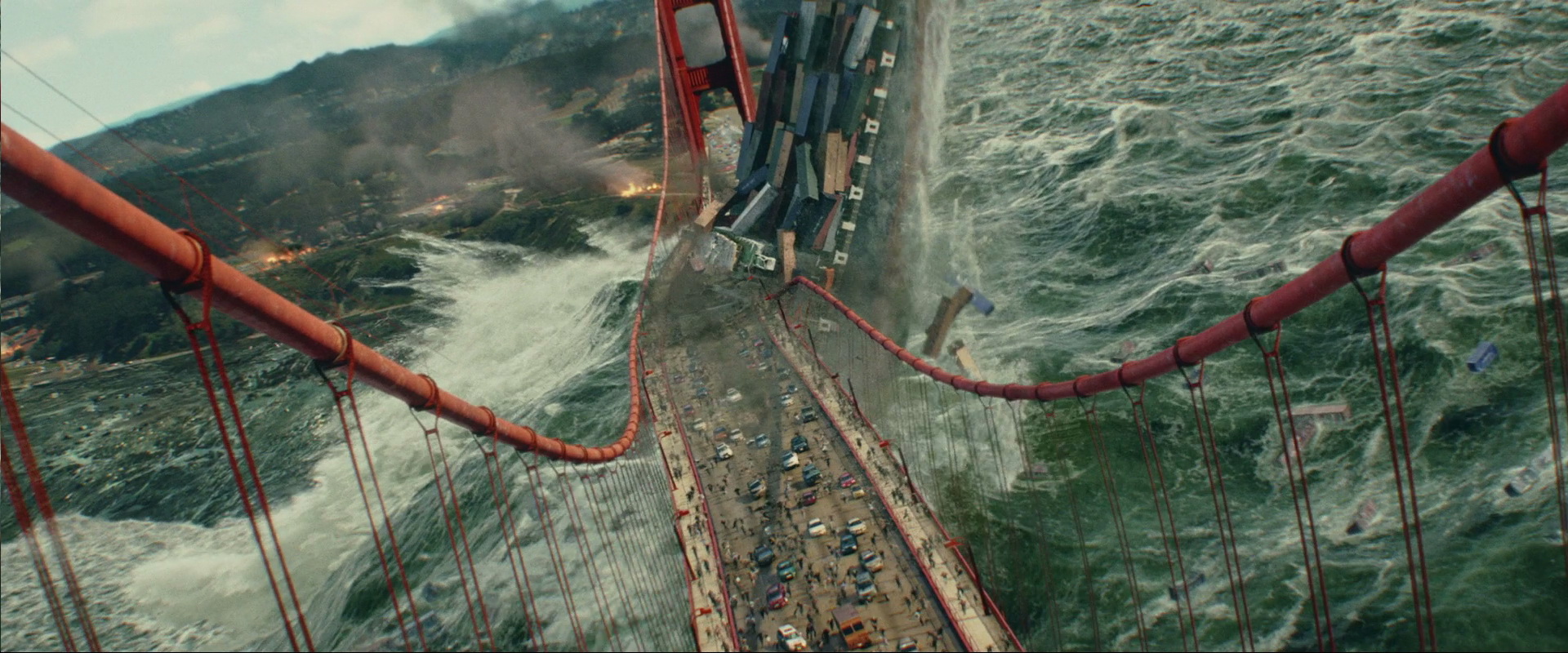《金门大桥,银光》是由路易莎(Louisa Wei)执导的纪录片,主要反映了中国女导演艾丝特·英(Esther Eng)的生活。在这部纪录片的开头,导演路易莎·魏(Louisa Wei)逃往旧金山,参观了以斯帖·魏(Esther Wei)的坟墓。当时,她问自己一个问题:“我能找到仍然认识她的人吗”(储,“金门”)。魏雅诗(Esther Wei)早在她的时代就赢得了相当的声誉和高度认可。但是从那以后,再也没有关于她的报道或评论了。就像她当时发生的一切只是一场梦。然后,导演路易莎·魏(Louisa Wei)通过这部纪录片《金门大桥》(Silver Light),努力使人们回到这个梦想。
首先,导演路易莎·韦使用多种技术来构建独特的电影结构。她通过构建这种多元结构使观众回到了梦想。为了构建这种电影结构,魏国威在这部电影中涵盖了许多社会背景信息,其中包括根据著名女作家Pearl Buck的小说,电影生涯和中国人的旅行而制作的《金地球》电影。女演员安娜·梅·王(Anna May Wong),中国的抗日战争,宋美龄的美国访问等等(储“金门”)。魏如珊建立了宏伟的社会和历史结构,使观众迅速而又有效地回到了以斯帖·魏曾经历的时代。此外,在影片中,露易莎(Louisa)展示了许多当时报纸的图片,其中报道了诸如电影制作,与其他女性的个人关系以及以斯帖威的死等事务。一方面,它通过证据增强了电影的可靠性,另一方面,它反映出当时以斯帖·恩格(Esther Eng)的声望和受欢迎程度。 Louisa Wei还展示了她收集信息和采访可以提供有关Esther Eng有用信息的人们的过程的许多片段。她为观众创造了一个机会,可以跟随她的脚步,越来越接近主要角色Esther Eng。从宏观角度到微观角度,路易莎·魏为观众建立了一个多元的电影结构,并逐步带动观众走进以斯帖·恩格的梦想。
其次,路易莎·韦(Louisa Wei)使用不同的方式在她的电影中展示时间,并使观众梦想成真并充满活力。通常,如何展现时间是叙事作品(如纪录片)面前的常见问题。梦想在某种程度上也是由时间造成的。在影片中,路易莎·魏(Louisa Wei)使用许多交通工具来显示时间的流逝,例如汽车,火车和飞机(楚,“金门”)。这些从一侧运输的方式打破了空间的限制,使观众转移到了不同的场景,而另一侧则展示了以斯帖·英格生活的时间表。此外,影片中一次又一次地出现了河流和桥梁的图像,并在某种程度上告诉观众,生活可能是一种循环。此外,电影由路易莎·韦(Louisa Wei)分为六个章节,这给这部纪录片赋予了更多的文本意义,也可以帮助观众获得更清晰的时间感。观众乘坐汽车,火车和飞机与导演一起从一个地方搬到另一个地方,并目睹了Esther Eng一生中发生的变化和事件。因此,无论是从时间角度还是从空间角度,观众都可以在矮路上移动并与Esther Eng保持相同的步伐和步骤。

First of all, the director Louisa Wei used multiple techniques to build a unique film structure. She took the audience back to the dream by building this polynary structure. To construct this film structure, Louisa Wei covered a lot of social background information in this film, including the film of Gold Earth was produced based on the fiction written by a famous female writer Pearl Buck, the film career and trip to China of a Chinese actress Anna May Wong, the Anti-Japanese war of China, Song Meiling’s visit to the United States, and so on (Chu,"Golden Gate"). Louisa Wei built a grand social and historical structure which quickly and effectively took the audience back to the time that Esther Wei had experienced. Besides, in the film, Louisa exhibited many pictures of the newspapers of that time, which reported affairs like the film productions, personal relationships with other women, and the death of Esther Wei. It, on one hand, strengthened the reliability of the film with evidence, and on the other hand, it showed reflected how famous and popular that Esther Eng was at that time. Louisa Wei also demonstrated many fragments of the process of her collecting information and interviewing people who can provide some useful information about Esther Eng. She created an opportunity for the audience to follow her steps and walk closer and closer towards the main character Esther Eng. Louisa Wei built a polynary film structure for the audience from a macro perspective to micro perspective and gradually took the audience to walk into the dream on Esther Eng.
Second, Louisa Wei used different ways to demonstrate time in her film and made the dream live and dynamic to the audience. Usually, how to demonstrate time is a common question in front of narrative artworks, such as documentary films. While a dream, to some point, is also made of time. In the film, Louisa Wei used many icons of transportation to show the passage of time, such as cars, trains, and flights (Chu, "Golden Gate"). Those ways of transportation from one side broke the limits of space and took the audience to transfer to different scenes, and on the other side exhibited the timeline of Esther Eng’s life. Besides, the images of rivers and bridges showed up again and again in the film, and to some extent, it told the audience that life could be a kind of circulation. Furthermore, the film was divided into six chapters by Louisa Wei, which gave the documentary film more meanings on textual bases and could also help the audience to gain a clearer sense of time. The audience took cars, trains, and flights to move from a place to another place with the director and to witness the changes and events that had happened in Esther Eng’s life. Thus, the audience could move in the dram and keep the same paces and steps with Esther Eng from a time perspective and from space perspective as well.
At the very beginning of the film, it said that this film was made to "dedicated to all pioneer women filmmakers and in celebration of the centennial of Esther Eng, Southern China’s first woman director" (Chu, "Golden Gate"). Louisa Wei tried to recall people’ memories about the incredible female director Esther Eng, to show her respects to Esther and her great contributions to war defense film and women cinema (Kar and Bren 102). Louisa eventually took the audience back to the dream when Esther was famous and unique and contributed her own power to the tough time, to the film field, and to the women world.
第三,这部纪录片的角色,以斯帖·恩格(Esther Eng)本身,令人难以置信,似乎只能出现在一个梦幻般的故事中。因此,听众逐渐逐渐了解Esther Eng及其复杂的社会身份的过程更像是试图清晰地了解梦中令人难以置信的人物。 Esther Eng身份的复杂性体现在很多方面。首先,Esther Eng是好莱坞的中国女导演,这在基本上充满了男导演的领域是非常独特的(魏39)。第二,Esther Eng总是打扮得像个男人,并且与其他女人有密切的关系,这暗示了她的同性恋倾向(Chu,“金门”)。这在她的时代也是一个大问题。第三,Esther Eng是居住在美国的中国妇女,她爱国,并制作了许多以爱国主义为主题的电影(魏40)。这使她的身份更加复杂。她在现实生活中扮演了许多不同的角色。每个角色,无论她的性别,性取向,种族和民族,都各不相同,其中有些甚至在当时引起争议。所有这些角色都融入了她,她是一个传奇人物,只能出现在梦幻般的场景中,尤其是对观众而言。
电影开头提到,这部电影是“献给所有先锋女性电影制片人的,是为了庆祝中国南方第一位女导演英格琳·恩格斯特诞辰一百周年”(朱,“金门”)。露易莎·魏(Louisa Wei)试图回想起人们对令人难以置信的女导演以斯帖·英(Esther Eng)的回忆,以表达她对以斯帖(Esther)的尊重以及她对战争防御电影和女性电影院的杰出贡献(Kar and Bren 102)。路易莎最终将观众带回到以斯帖闻名于世的梦想,并为艰难的时光,电影界和女性世界贡献了自己的力量。
Third, the character of this documentary film, Esther Eng herself, was incredible and seemed to can only show up in a dreamlike story. Thus, the process that the audience gradually got to know more about Esther Eng and her complex social identity would be more like trying to get a clear vision of the incredible figure in the dream. The complexities of Esther Eng’s identity was reflected in many aspects. First, Esther Eng was a Chinese female director in Hollywood, which was quite unique in a field that basically full of male directors (Wei 39). Second, Esther Eng always dressed up like a man and had close relationships with other women, which implied her homosexual tendency (Chu, "Golden Gate"). This was also a big issue in her time. Third, Esther Eng was a Chinese woman who lived in the United States, and she was patriotic and produced many films with patriotism as the theme (Wei 40). This made her identity even more complex. She played so many different roles in her real life. Each of the roles, no matter about her gender, her sexual orientation, her race, and nation were all unique, and some of them were even controversial at that time. All those roles combined into her, a legendary character who could only show up in a dreamlike scene, especially to the audience.At the very beginning of the film, it said that this film was made to "dedicated to all pioneer women filmmakers and in celebration of the centennial of Esther Eng, Southern China’s first woman director" (Chu, "Golden Gate"). Louisa Wei tried to recall people’ memories about the incredible female director Esther Eng, to show her respects to Esther and her great contributions to war defense film and women cinema (Kar and Bren 102). Louisa eventually took the audience back to the dream when Esther was famous and unique and contributed her own power to the tough time, to the film field, and to the women world.
Works Cited
Chu, Karen. "Golden Gate Silver Light Doc Reveals Life of First Chinese-American Female Director." The Hollywood Reporter Apr.1st, 2013: n. pag. Print.
Kar, Law, and Frank Bren. "The Esther Eng Story. " Hong Kong Cinema: A Cross-Cultural View 2004: 91-105. Print.
Wei, Louisa. "Finding Voices Through Her Images." Feminist Media Histories 2016: 32-46. Print.










